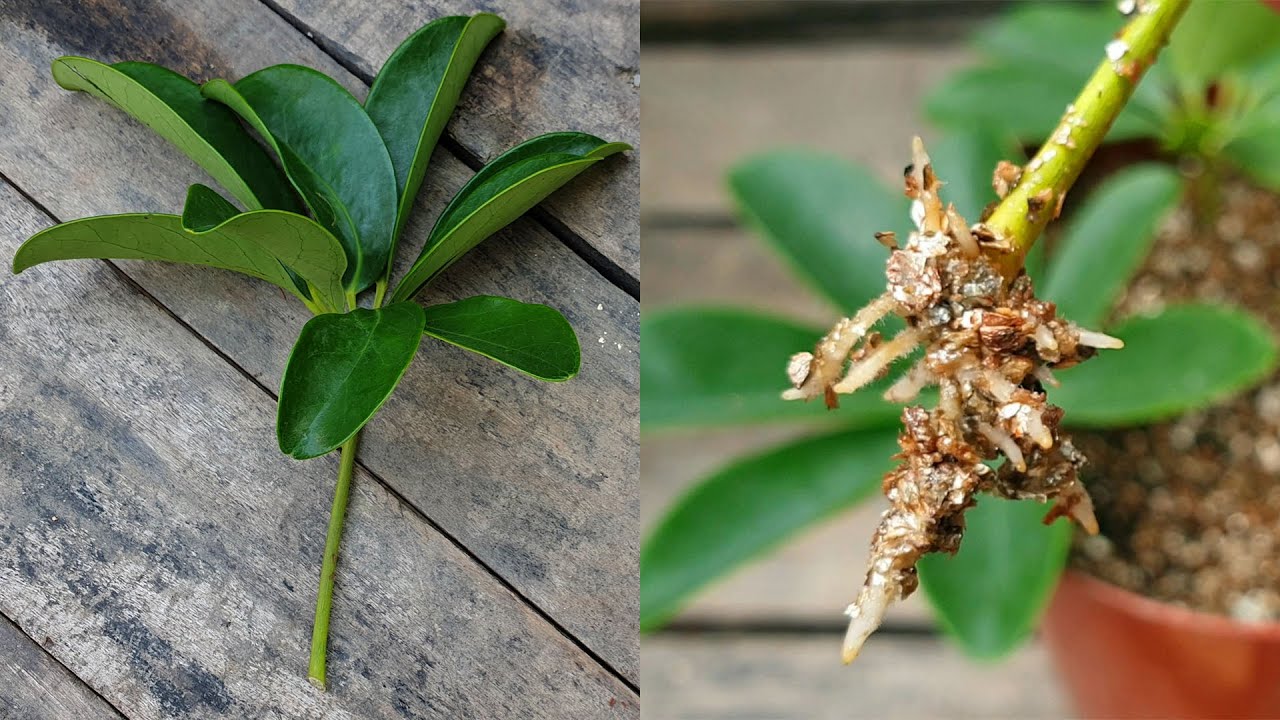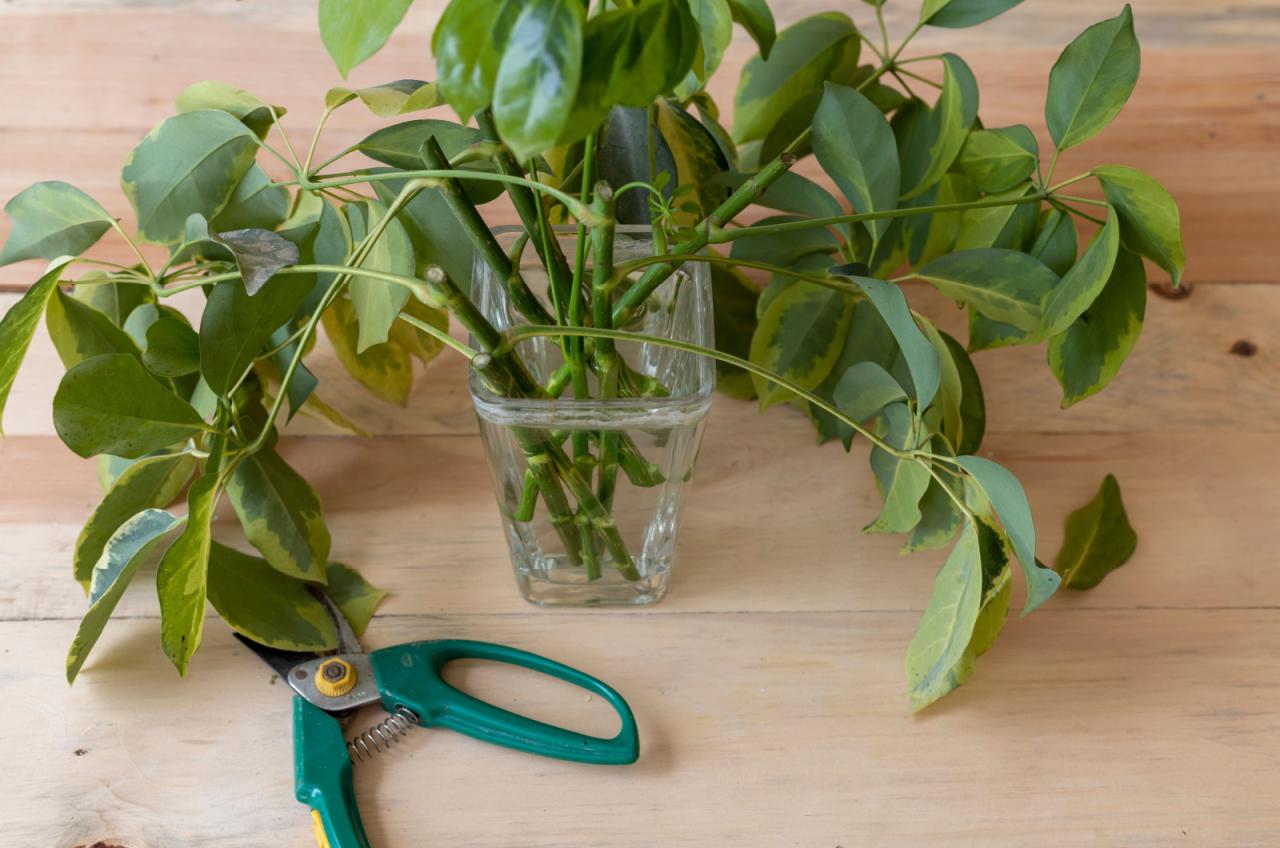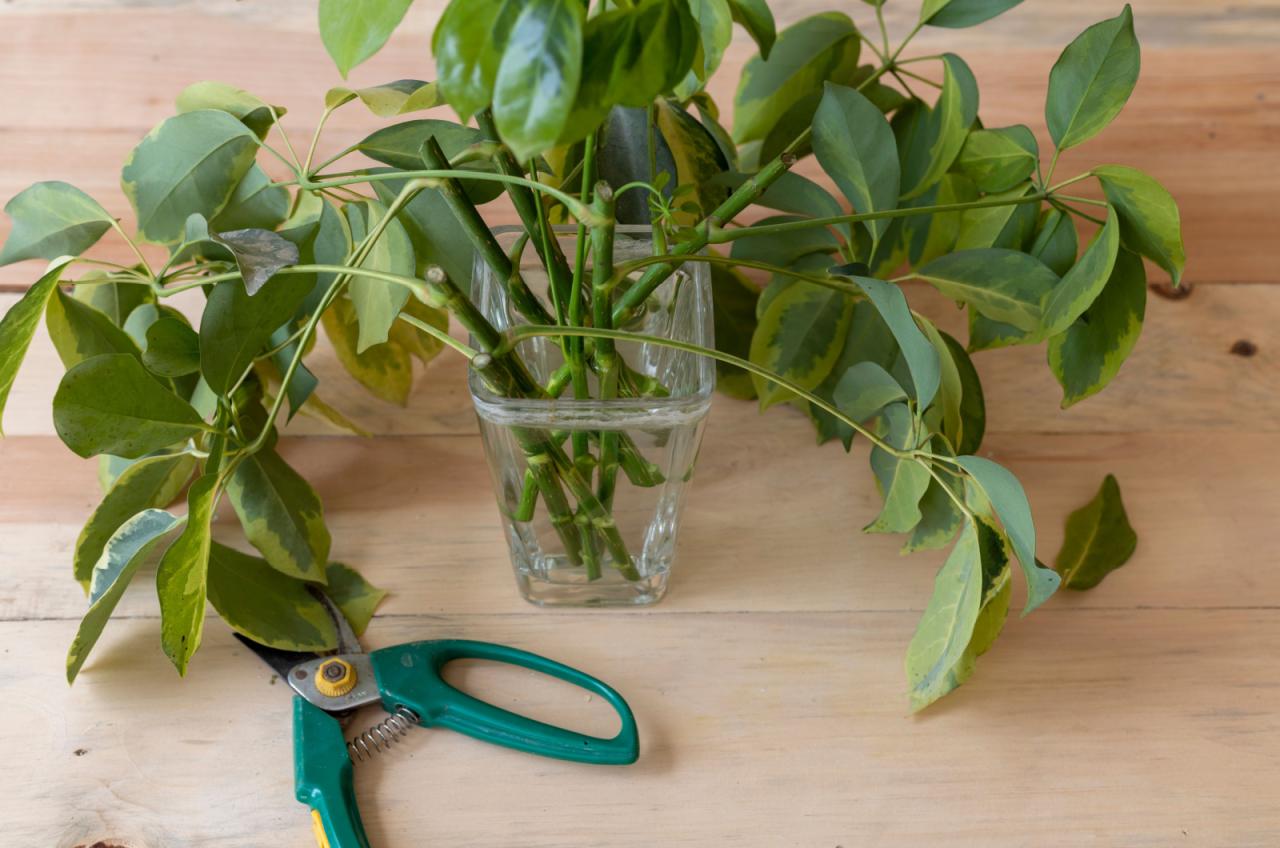How to Create a Vibrant Schefflera Collection Using Propagation Techniques is a comprehensive guide for plant enthusiasts seeking to expand their indoor greenery with these adaptable and attractive houseplants. Schefflera, also known as the umbrella tree, offers a diverse range of varieties, each with its unique foliage and growth habits.
This guide will delve into the fascinating world of Schefflera propagation, empowering you to cultivate a thriving collection from the comfort of your home.
From understanding the basic characteristics of Schefflera plants to mastering various propagation techniques, this guide will equip you with the knowledge and skills to successfully propagate these beautiful plants. You’ll learn about stem cuttings, air layering, and seed propagation, along with the optimal conditions for each method.
Furthermore, we’ll explore the diverse range of Schefflera varieties and provide tailored propagation techniques for each, ensuring success in your journey to creating a vibrant collection.
Understanding Schefflera Plants
Schefflera plants, also known as umbrella trees, are a popular choice for indoor gardening due to their adaptability and low-maintenance nature. These striking plants boast a unique appearance with their large, compound leaves that resemble an open umbrella, adding a touch of tropical flair to any space.
Their ability to thrive in various light conditions and tolerate occasional neglect makes them ideal for busy homeowners or those new to plant care.
Schefflera Varieties
Schefflera plants encompass a diverse range of varieties, each with its own distinct characteristics and visual appeal. Here are some of the most popular Schefflera varieties:
- Schefflera arboricola:This variety, commonly known as the dwarf umbrella tree, is the most widely cultivated Schefflera species. It features smaller leaves compared to other varieties and is known for its adaptability and tolerance to various light conditions. It is a popular choice for indoor gardens due to its compact size and attractive foliage.
- Schefflera actinophylla:Also known as the Australian umbrella tree, this variety is characterized by its larger leaves and distinctive red berries that develop after flowering. This variety is a statement piece for any indoor space, adding a touch of tropical grandeur with its bold foliage and vibrant red berries.
- Schefflera elegantissima:This variety, commonly known as the lace-leaf Schefflera, is a striking choice for indoor gardens with its unique foliage. Its leaves are deeply divided, creating a delicate and intricate pattern that adds a touch of elegance to any space. This variety prefers bright, indirect light and moderate humidity.
History of Schefflera Cultivation
Schefflera plants are native to tropical and subtropical regions of the world, primarily found in Southeast Asia, Australia, and the Pacific Islands. Their cultivation dates back centuries, with records indicating their use in traditional medicine and for decorative purposes.Schefflera plants were introduced to the Western world in the 19th century, quickly gaining popularity as indoor plants due to their adaptability and ease of care.
Their unique foliage and ability to thrive in various light conditions made them a desirable addition to homes and offices.Today, Schefflera plants continue to be a popular choice for indoor gardening, with new varieties being developed and introduced to the market.
Creating a vibrant Schefflera collection is a rewarding endeavor, and propagation techniques are key to success. While Scheffleras can be propagated through cuttings, they can also be grown from seeds. For those seeking a simpler approach, the propagation methods for Mother of Thousands offer valuable insight.
Check out The Simplest Way to Propagate Mother of Thousands and Achieve Success for inspiration. By understanding the principles of propagation, you can cultivate a flourishing Schefflera collection that will bring life and beauty to your home.
Their versatility and adaptability make them a perfect choice for both novice and experienced plant enthusiasts.
The Power of Propagation

Propagation, the art of creating new plants from existing ones, unlocks a world of possibilities for Schefflera enthusiasts. It’s a rewarding practice that not only expands your collection but also allows you to share the beauty of these vibrant plants with others.
Benefits of Propagation
Propagating Schefflera plants offers numerous advantages. The most notable is its cost-effectiveness. By starting new plants from cuttings or air layers, you can significantly reduce your spending on purchasing new specimens. Moreover, propagation allows you to experiment with different varieties and cultivate a diverse collection of Schefflera plants, each with its unique charm.
Comparison of Propagation Techniques
Schefflera plants can be propagated using various methods, each with its own advantages and considerations.
Stem Cuttings
Stem cuttings are the most common and straightforward propagation method for Schefflera. This technique involves taking a section of healthy stem, typically 4-6 inches long, with at least two leaf nodes. The lower leaves are removed, and the cutting is placed in a rooting medium, such as a mixture of perlite and vermiculite, or a water-based solution.
The cutting should be kept in a warm, humid environment with indirect sunlight, and roots will typically develop within a few weeks.
Air Layering
Air layering is a technique that allows you to root a new plant while it is still attached to the parent plant. This method is particularly useful for Schefflera plants with thick stems. To perform air layering, a ring of bark is removed from the stem, and the exposed area is covered with moist sphagnum moss.
The moss is then wrapped in plastic and secured with tape. Roots will develop within a few months, and the new plant can then be separated from the parent plant.
Seed Propagation
While less common, Schefflera plants can also be propagated from seeds. This method involves sowing the seeds in a seed starting mix and providing them with adequate moisture and warmth. Seed propagation is a more time-consuming process than cuttings or air layering, and the resulting plants may not always be true to the parent plant.
Optimal Time and Conditions for Propagation
The success of Schefflera propagation depends on several factors, including the time of year and the environmental conditions. The best time to propagate Schefflera plants is during the spring or early summer when the plant is actively growing.
Optimal Conditions
To ensure successful propagation, it is essential to provide the cuttings or air layers with the following conditions:
- Warm Temperatures:Schefflera plants thrive in warm temperatures, ideally between 70-80°F (21-27°C).
- High Humidity:Maintain a high humidity level around the cuttings or air layers to prevent them from drying out.
- Indirect Sunlight:Provide the cuttings or air layers with bright, indirect sunlight.
- Well-Draining Rooting Medium:Use a well-draining rooting medium to prevent root rot.
Mastering Propagation Techniques
Schefflera propagation is a rewarding process that allows you to expand your collection and share these beautiful plants with others. With the right techniques, you can successfully propagate Schefflera plants from stem cuttings, air layers, and seeds.
Stem Cuttings
Stem cuttings are the most common and straightforward method of propagating Schefflera plants. This method involves taking a section of healthy stem and encouraging it to develop roots.
- Prepare the Cuttings:Select a healthy stem from a mature Schefflera plant. Use a sharp, clean knife or pruning shears to make a cut just below a node, the point where a leaf or branch grows. Remove any leaves below the cut.
- Dip in Rooting Hormone:To enhance root development, dip the cut end of the stem cutting in rooting hormone powder or liquid. Rooting hormone contains plant growth regulators that stimulate root formation.
- Potting the Cuttings:Fill a small pot with a well-draining potting mix. Make a hole in the center of the potting mix and insert the stem cutting. Gently firm the potting mix around the base of the cutting.
- Provide Moisture and Humidity:Water the cutting thoroughly and place a plastic bag or dome over the pot to create a humid environment. This helps to prevent the cutting from drying out.
- Maintain Proper Conditions:Place the pot in a bright, indirect light location. Avoid direct sunlight, which can scorch the leaves. Keep the potting mix consistently moist but not waterlogged.
- Patience and Monitoring:It can take several weeks or months for the cutting to develop roots. Monitor the cutting regularly for signs of root growth, such as new leaves or stems emerging from the base.
Air Layering
Air layering is a technique that involves encouraging roots to develop on a stem while it is still attached to the parent plant. This method is particularly effective for Schefflera plants.
Creating a vibrant Schefflera collection through propagation techniques is a rewarding journey. Similar to the ease of multiplying Mother of Thousands, as outlined in Can You Propagate Mother of Thousands? Here’s How to Do It Right , Schefflera plants readily produce new growth from cuttings.
With a bit of patience and the right technique, you can quickly expand your collection of these beautiful, foliage-filled plants.
- Choose a Suitable Branch:Select a healthy branch that is at least 1/2 inch in diameter and has several nodes. The branch should be flexible enough to bend without breaking.
- Make a Cut:Using a sharp knife or pruning shears, make a cut through the bark of the branch, about 1 inch long and halfway through the stem.
- Apply Rooting Hormone:Dip a cotton swab or small brush in rooting hormone powder and apply it to the cut surface of the branch.
- Wrap with Sphagnum Moss:Moisten sphagnum moss with water and wrap it around the cut section of the branch. Secure the moss with plastic wrap or aluminum foil.
- Maintain Moisture:Keep the moss consistently moist by periodically misting it with water.
- Root Development:Roots will typically develop within several weeks or months. Once the roots are visible, you can cut the branch below the air layer and pot it in a separate container.
Propagating Schefflera Plants from Seeds
Propagating Schefflera plants from seeds is a less common but still achievable method.
- Collect Seeds:Schefflera plants produce small, berry-like fruits that contain seeds. Collect ripe fruits from the plant and extract the seeds.
- Seed Preparation:Clean the seeds by rinsing them in water to remove any pulp or debris. Soak the seeds in water for 24 hours to soften the seed coat and improve germination.
- Sowing the Seeds:Fill a seed tray or small pots with a well-draining seed starting mix. Sow the seeds about 1/4 inch deep and cover them with a thin layer of potting mix.
- Germination Conditions:Place the seed tray or pots in a warm, bright location with indirect light. Keep the potting mix consistently moist but not waterlogged.
- Germination Time:Schefflera seeds can take several weeks or months to germinate. Patience is key.
- Transplanting Seedlings:Once the seedlings have developed several true leaves, they can be transplanted into individual pots with a well-draining potting mix.
Cultivating a Vibrant Collection
With a solid understanding of propagation techniques, you’re ready to cultivate a thriving Schefflera collection. This involves selecting the right varieties, providing optimal growing conditions, and nurturing their growth for a lush and vibrant display.
Schefflera Varieties and Their Preferences
Choosing the right Schefflera varieties is crucial for a successful collection. Each variety has unique preferences, influencing their growth and overall aesthetic. The following table provides a quick guide:
Variety |
Preferred Growing Conditions |
Suitable Propagation Techniques |
|---|---|---|
Schefflera arboricola (Dwarf Umbrella Tree) |
Bright indirect light, well-draining soil, moderate humidity |
Stem cuttings, air layering |
Schefflera actinophylla (Australian Umbrella Tree) |
Bright indirect light, well-draining soil, moderate humidity |
Stem cuttings, air layering |
Schefflera elegantissima (False Aralia) |
Bright indirect light, well-draining soil, moderate humidity |
Stem cuttings, air layering |
Schefflera venulosa (Variegated Umbrella Tree) |
Bright indirect light, well-draining soil, moderate humidity |
Stem cuttings, air layering |
Building a Vibrant Collection: A Step-by-Step Guide
Creating a diverse and thriving Schefflera collection is a rewarding journey. Here’s a step-by-step guide to help you:
- Start with Propagation:Begin by propagating your chosen Schefflera varieties using the suitable techniques Artikeld in the table. This allows you to expand your collection efficiently and affordably.
- Establish a Suitable Environment:Provide your Scheffleras with their preferred growing conditions, including bright indirect light, well-draining soil, and moderate humidity. This sets the foundation for healthy growth.
- Regular Watering and Fertilization:Water your Scheffleras when the top inch of soil feels dry to the touch. Fertilize during the growing season (spring and summer) with a balanced liquid fertilizer to provide essential nutrients.
- Pruning for Shape and Health:Prune your Scheffleras regularly to maintain their desired shape and remove any dead or diseased branches. Pruning also encourages bushier growth and prevents legginess.
- Repotting as Needed:Repot your Scheffleras into larger pots when they become rootbound. This allows for optimal growth and prevents stunted development.
- Monitor for Pests and Diseases:Regularly inspect your Scheffleras for signs of pests or diseases. Early detection and treatment are essential for maintaining their health.
Tips for Maximizing Growth and Preventing Problems, How to Create a Vibrant Schefflera Collection Using Propagation Techniques
- Light:While Scheffleras thrive in bright indirect light, avoid exposing them to direct sunlight, which can scorch their leaves. Rotate your plants regularly to ensure even growth.
- Watering:Overwatering is a common problem for Scheffleras, leading to root rot. Allow the soil to dry slightly between waterings to prevent this issue. Use well-draining potting mix to ensure proper drainage.
- Humidity:Scheffleras prefer moderate humidity. Consider placing them on a pebble tray filled with water or using a humidifier during dry periods.
- Fertilization:Fertilize your Scheffleras during the growing season with a balanced liquid fertilizer to provide essential nutrients for healthy growth. Overfertilization can also cause problems, so follow the instructions on the fertilizer label carefully.
- Pests and Diseases:Monitor your Scheffleras regularly for signs of pests like spider mites, mealybugs, or aphids. Treat infestations promptly with appropriate methods, such as insecticidal soap or neem oil. Be vigilant about fungal diseases like leaf spot, which can be prevented by ensuring good air circulation and avoiding overwatering.
Displaying Your Schefflera Collection
The beauty of your Schefflera collection doesn’t end with propagation. Displaying your plants is a crucial step in showcasing their versatility and aesthetic appeal. Whether you’re aiming for a minimalist, bohemian, or any other interior design style, Schefflera plants can effortlessly complement your vision.
Creative Schefflera Displays
The versatility of Schefflera plants allows for diverse display options. Here are some ideas for showcasing your collection in eye-catching arrangements:
- Individual Stands:Elevate your Schefflera plants on decorative stands or pedestals. This creates a sense of height and visual interest, allowing the plants to become focal points in your space.
- Hanging Baskets:Schefflera varieties with trailing growth habits are perfect for hanging baskets. This creates a cascading effect, adding a touch of elegance and verticality to your interior.
- Shelving Units:Arrange your Schefflera plants on open shelving units, creating a tiered display that maximizes space and showcases the different sizes and textures of your collection.
- Mixed Arrangements:Combine different Schefflera varieties with other houseplants to create dynamic arrangements. For instance, pair a Schefflera with a trailing vine, a succulent, or a flowering plant for a visually captivating display.
Incorporating Schefflera Plants into Interior Design Styles
Schefflera plants seamlessly blend into various interior design styles, adding a touch of greenery and sophistication to your space.
- Minimalist:Schefflera’s clean lines and minimalist aesthetic make them a perfect fit for modern and minimalist interiors. Choose varieties with deep green foliage for a sleek and sophisticated look.
- Bohemian:The lush, textured foliage of Schefflera plants adds a touch of natural beauty to bohemian spaces. Consider using hanging baskets or placing them on macrame hangers for a relaxed and eclectic vibe.
- Tropical:Schefflera plants, especially varieties with variegated leaves, evoke a tropical ambiance. Combine them with other tropical plants like ferns and palms for a lush and vibrant jungle-inspired atmosphere.
Concluding Remarks: How To Create A Vibrant Schefflera Collection Using Propagation Techniques

By following the techniques Artikeld in this guide, you’ll be well on your way to creating a flourishing Schefflera collection that adds vibrancy and life to your home. From the initial propagation steps to ongoing care, you’ll gain valuable insights into maximizing growth, ensuring healthy development, and preventing common problems.
Embrace the joy of propagation and watch as your Schefflera collection transforms into a testament to your horticultural expertise, bringing a touch of nature’s beauty into your living space.
FAQ Overview
What are the best tools for propagating Schefflera plants?
You’ll need sharp pruning shears, a rooting hormone, a clean container, and a well-draining potting mix.
How often should I water my Schefflera cuttings?
Keep the potting mix consistently moist but not soggy. Allow the top inch of soil to dry slightly between waterings.
Can I propagate Schefflera from seed?
Yes, but it’s a slower process. Collect mature seeds from the plant and sow them in a seed starting mix. Maintain a warm and humid environment for germination.
